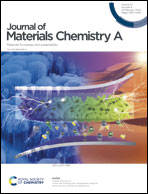Operando observation of CO2 transport intermediates in polyvinylamine facilitated transport membranes, and the role of water in the formation of intermediates, using transmission FTIR spectroscopy†
Abstract
Amine functional groups in polymeric facilitated transport membranes (FTMs) selectively facilitate CO2 transport across the membrane over other gases to give rapid and selective CO2 separation from mixed gas streams. However, the mechanisms by which the amine functional group facilitates CO2 transport are not well understood. Additionally, water vapor is known to enhance CO2 permeation across amine-based FTMs, but how exactly water influences the amine-facilitated CO2 transport mechanism is unknown. To address these fundamental aspects of CO2 facilitated transport, we have developed a novel operando transmission FTIR spectroscopy tool to directly observe the formation of CO2 transport intermediates (e.g. carbamate, bicarbonate) formed in amine-based FTMs under realistic operating conditions, including in humid CO2 gas mixtures, and correlate formation of specific CO2 transport intermediates to CO2 permeation rates measured simultaneously for the same sample. This work describes the design of this operando transmission FTIR spectroscopy tool and demonstrates its utility by investigating the mechanism of water-enhanced CO2 transport across polyvinylamine (PVAm), a prototypical FTM for CO2 separations. We show that CO2 moves across PVAm most likely as carbamate (R-NHCOO−) species, based on infrared band positions and literature assignments, and formation of carbamate species is facilitated by water in the CO2/N2 feed gas mixture. During exposure of PVAm to dry CO2/N2 feeds, carbamate species or other intermediates were not observed spectroscopically, and the CO2 flux across the membrane was below the detection limit. We speculate that water may facilitate the formation of carbamate, and thus enhance CO2 transport across the membrane, by catalyzing deprotonation of a zwitterion (R-NH2+COO−) intermediate to give carbamate species. This work clarifies the unknown mechanism of CO2 facilitated transport across PVAm, and the role of water in the transport mechanism, and establishes a new operando spectroscopy tool that can be used with a wide range of membrane systems to probe transport mechanisms, fouling mechanisms, and changes in membrane structure/performance over time.



 Please wait while we load your content...
Please wait while we load your content...